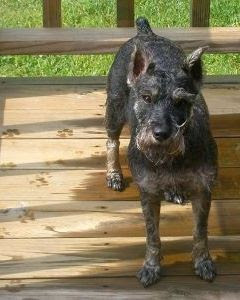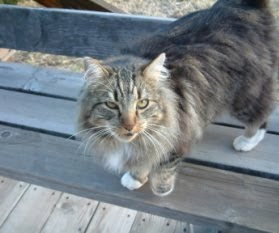Dogs
 By Ruthie Bently
By Ruthie Bently
Pressure treated wood was used for over 68 years in both residential and commercial applications. While it is no longer supposed to be used in residential applications, it’s been used to build decks, walkways, fences, picnic tables, raised garden beds, dog houses, and other structures where a wood that’s resistant to the elements is needed. However, pressure treated wood poses many dangers to our pets (as well as our families) that you may not be aware of.
The process for pressure-treating lumber was invented by Dr. Karl Wolman, and he was issued a U.S. patent for it on September, 29, 1942. The wood product created won’t decay or rot for over 20 years. The wood used was most prevalently preserved with chromate copper arsenate (CCA) and its use began to cease in 2004 due to safety concerns. However, it is still in use in several industrial applications and in some countries around the world. Arsenate is a salt or ester of arsenic acid, in short arsenic which is an exceedingly toxic chemical, as well as a known carcinogen. CCA toxicity can be caused by inhalation of gas created by burning CCA treated wood in a fire. It can also be caused by a dog eating the wood or ashes from a CCA wood fire. One tablespoon of ash from CCA wood contains a fatal dose of arsenic.
Splinters under the skin can cause an infection, and skin coming in contact with the treated wood or lumber can cause dermal irritation or a rash. One Wisconsin man reported his 85 pound Labrador began to show signs of lethargy, no energy and stiffness. It was thought that the dog was poisoned through inhalation of vapors inside his cage (made from CCA treated wood) or through skin contact or even ingesting the wood of the cage. A Pennsylvania man reported that he had been sawing CCA treated wood for about three months, and a few months into the project his dog died of unknown causes. Under certain conditions the chemicals used to preserve the wood can leach out. Arsenic is water soluble and can mix with rainwater puddling on a deck.
 How do you protect your pet if there is CCA treated wood on your property? Make sure there are no puddles on your deck after a rainstorm; watering the grass with a sprinkler or power washing windows might also cause the deck to get wet. Never feed, water or give treats to your pet on the deck, and keep their toys off the deck. Limit their access to the deck; if limiting access is not possible, consider a rug for them to lie on. When laundering any rug from the deck wash it by itself to keep from cross contaminating any other items you launder.
How do you protect your pet if there is CCA treated wood on your property? Make sure there are no puddles on your deck after a rainstorm; watering the grass with a sprinkler or power washing windows might also cause the deck to get wet. Never feed, water or give treats to your pet on the deck, and keep their toys off the deck. Limit their access to the deck; if limiting access is not possible, consider a rug for them to lie on. When laundering any rug from the deck wash it by itself to keep from cross contaminating any other items you launder.
Check the deck to see if it needs to be resanded to prevent paw splinters. Wash your pet’s paws and fur after their contact with the deck. Don’t let your pet play in wood chips or soil under or around CCA treated wood unless they test negative for arsenic.
If you’re building or buying a dog house, make sure it is not made with pressure-treated wood. To protect the wood, use paint, stain or oil that is non-toxic. If you have an outdoor project, consider vinyl alternatives or naturally resistant woods like cedar or redwood. Use reclaimed cedar or redwood. Use regular wood and treat with linseed oil or non-toxic stain or paint, and replace it more often.
As the use of CCA as a wood preservative is being discontinued, other preservatives that use the same process are taking its place: Amine Copper Quat (ACQ-D), Copper Azole (CA), Alkaline Copper Quaternary (ACQ) or Quat for short, and Amoniacal Copper Zinc Arsenate (ACZA). There are pros and cons on both sides of the issue, and if you’re a pet owner I would suggest caution when using any pressure-treated wood.
If you believe that your dog or cat may have been exposed to CCA, you can contact the following poison hotlines for information on symptoms and treatment, as well as prevention of a future incident.
Pet Poison Helpline website, (800) 213-6680. Calls from the United States are answered 24 hours a day.
ASPCA Animal Poison Control Center. Available 24 hours a day for emergencies at: (888) 426-4435.
Read more articles by Ruthie Bently
- Solid Waste Management For Dogs
by Carrie Boyko, CEB Help Keep it Green Wow; is that a compelling title or what?! For some weeks now I've had the pleasure of viewing a dumpster and porta-potty outside my office window. As I watch my neighbors walk by, I frequently see a bag of...
- Creative Pet Adoption Strategies
As told by Darcy Gray to Carrie Boyko, CEB © Animal Shelter of the Wood River Valley GracieDear Carrie: I went on a brief road trip to Idaho last week and stopped by the Iconoclast bookstore in Ketchum. At the register, I noticed a display advertising...
- How To Remove Pet Odors From Wood Floors
Unfortunately, wood absorbs everything including pet odors, and removing pet odors from hardwood can be a tedious process. If your pet urinates, the best case scenario would be to get to the puddle as soon as possible, blot with vinegar then spray the...
- Dogs Never Stop Chewing
By Ruthie Bently I recently bought Skye a sterilized natural bone, and she was in her yard chewing on it when a friend came over. He asked me how old Skye was and I replied that she would be four this summer. That surprised him, because she was still...
- Dog Houses For Large Dogs
It is fun to have your puppy running around the house but as it grows bigger things get a little difficult, more so for the dog. Large dogs need space just like we do, therefore finding them the right dog kennel becomes important. Purchasing doghouses...
Dogs
The Dangers of Treated Wood for Pets

Pressure treated wood was used for over 68 years in both residential and commercial applications. While it is no longer supposed to be used in residential applications, it’s been used to build decks, walkways, fences, picnic tables, raised garden beds, dog houses, and other structures where a wood that’s resistant to the elements is needed. However, pressure treated wood poses many dangers to our pets (as well as our families) that you may not be aware of.
The process for pressure-treating lumber was invented by Dr. Karl Wolman, and he was issued a U.S. patent for it on September, 29, 1942. The wood product created won’t decay or rot for over 20 years. The wood used was most prevalently preserved with chromate copper arsenate (CCA) and its use began to cease in 2004 due to safety concerns. However, it is still in use in several industrial applications and in some countries around the world. Arsenate is a salt or ester of arsenic acid, in short arsenic which is an exceedingly toxic chemical, as well as a known carcinogen. CCA toxicity can be caused by inhalation of gas created by burning CCA treated wood in a fire. It can also be caused by a dog eating the wood or ashes from a CCA wood fire. One tablespoon of ash from CCA wood contains a fatal dose of arsenic.
Splinters under the skin can cause an infection, and skin coming in contact with the treated wood or lumber can cause dermal irritation or a rash. One Wisconsin man reported his 85 pound Labrador began to show signs of lethargy, no energy and stiffness. It was thought that the dog was poisoned through inhalation of vapors inside his cage (made from CCA treated wood) or through skin contact or even ingesting the wood of the cage. A Pennsylvania man reported that he had been sawing CCA treated wood for about three months, and a few months into the project his dog died of unknown causes. Under certain conditions the chemicals used to preserve the wood can leach out. Arsenic is water soluble and can mix with rainwater puddling on a deck.

Check the deck to see if it needs to be resanded to prevent paw splinters. Wash your pet’s paws and fur after their contact with the deck. Don’t let your pet play in wood chips or soil under or around CCA treated wood unless they test negative for arsenic.
If you’re building or buying a dog house, make sure it is not made with pressure-treated wood. To protect the wood, use paint, stain or oil that is non-toxic. If you have an outdoor project, consider vinyl alternatives or naturally resistant woods like cedar or redwood. Use reclaimed cedar or redwood. Use regular wood and treat with linseed oil or non-toxic stain or paint, and replace it more often.
As the use of CCA as a wood preservative is being discontinued, other preservatives that use the same process are taking its place: Amine Copper Quat (ACQ-D), Copper Azole (CA), Alkaline Copper Quaternary (ACQ) or Quat for short, and Amoniacal Copper Zinc Arsenate (ACZA). There are pros and cons on both sides of the issue, and if you’re a pet owner I would suggest caution when using any pressure-treated wood.
If you believe that your dog or cat may have been exposed to CCA, you can contact the following poison hotlines for information on symptoms and treatment, as well as prevention of a future incident.
Pet Poison Helpline website, (800) 213-6680. Calls from the United States are answered 24 hours a day.
ASPCA Animal Poison Control Center. Available 24 hours a day for emergencies at: (888) 426-4435.
Read more articles by Ruthie Bently
- Solid Waste Management For Dogs
by Carrie Boyko, CEB Help Keep it Green Wow; is that a compelling title or what?! For some weeks now I've had the pleasure of viewing a dumpster and porta-potty outside my office window. As I watch my neighbors walk by, I frequently see a bag of...
- Creative Pet Adoption Strategies
As told by Darcy Gray to Carrie Boyko, CEB © Animal Shelter of the Wood River Valley GracieDear Carrie: I went on a brief road trip to Idaho last week and stopped by the Iconoclast bookstore in Ketchum. At the register, I noticed a display advertising...
- How To Remove Pet Odors From Wood Floors
Unfortunately, wood absorbs everything including pet odors, and removing pet odors from hardwood can be a tedious process. If your pet urinates, the best case scenario would be to get to the puddle as soon as possible, blot with vinegar then spray the...
- Dogs Never Stop Chewing
By Ruthie Bently I recently bought Skye a sterilized natural bone, and she was in her yard chewing on it when a friend came over. He asked me how old Skye was and I replied that she would be four this summer. That surprised him, because she was still...
- Dog Houses For Large Dogs
It is fun to have your puppy running around the house but as it grows bigger things get a little difficult, more so for the dog. Large dogs need space just like we do, therefore finding them the right dog kennel becomes important. Purchasing doghouses...
